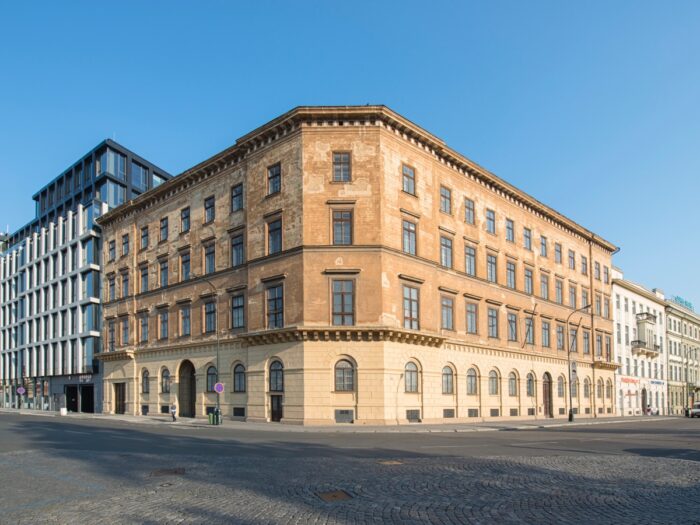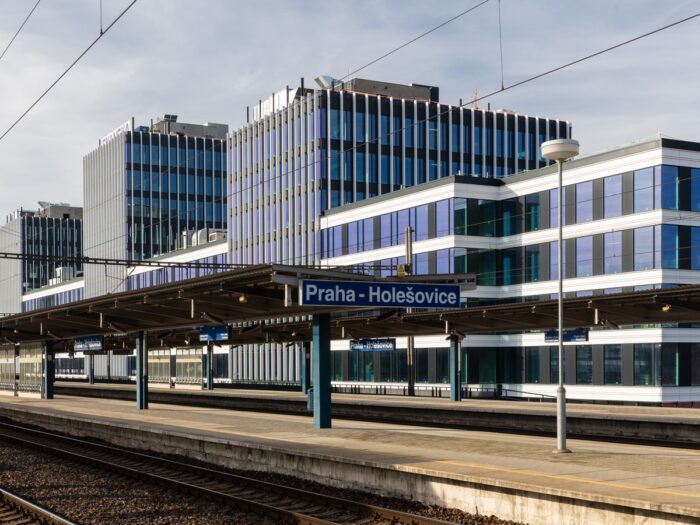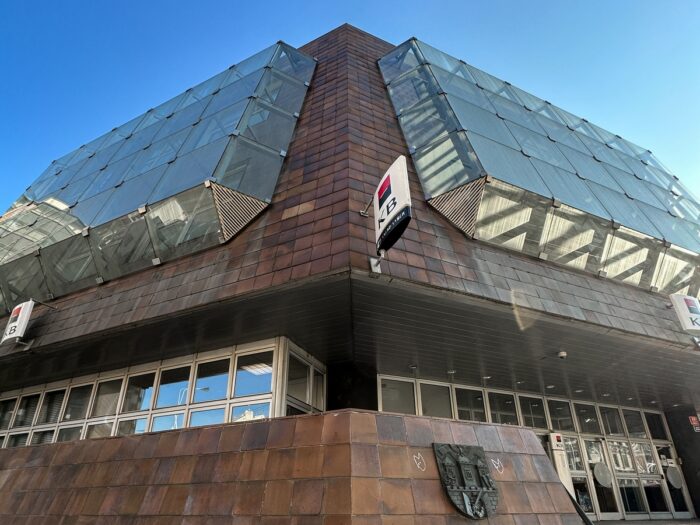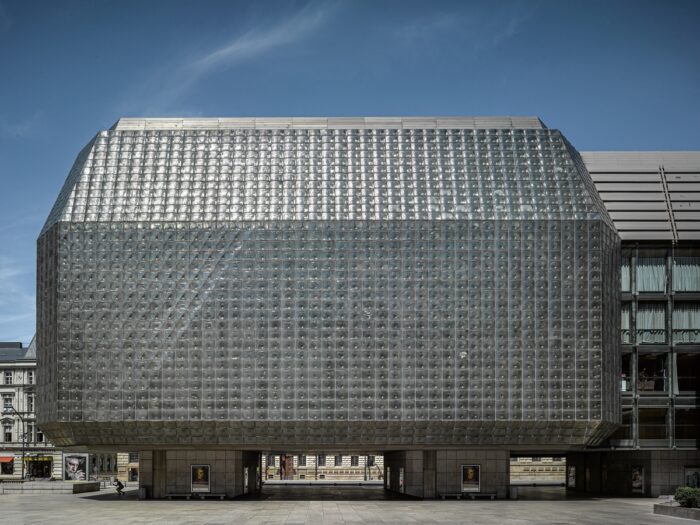Do you need help deciding which buildings to visit during Open House Prague 2023 on the weekend of May 20–21, or are you just looking for inspiration? Below is a list of carefully selected buildings and premises that offer a wide range of architecture styles. You can visit monumental, opulent constructions in the heart of Prague, see several examples of modern architecture, and visit various parts of Prague such as Holešovice, Smíchov, and Ruzyně. Admission to all buildings is free with no need for prior registration, except for Hotel Intercontinental. Selected buildings also offer guided tours in English throughout the day – availability is indicated by an icon in the description of each building.
Representative & Historical Buildings

Adria Palace
This monumental palace is one of Prague’s few buildings built in the national style. This purely Czech artistic style (also called Art Deco, rondocubism, or Czech deconstructivism) incorporated references to folklore, Slavic colorfulness, and a greater amount of decorativeness. Today’s art historians agree that Adria Palace is one of the most fascinating architectural monuments in Prague, commending the decorations and details.

City Mayor’s Residence
The plain neoclassical façade of the Municipal Library in Prague hides exceptional interiors that were influenced by late Art Nouveau and Art Deco, and many significant Czech artists were involved in the decoration process. The first floor features representative rooms and reception rooms, and on the third floor, there is a private apartment of the city mayor as well as three apartments for distinguished visitors from abroad.


Desfours Palace
The palace’s plain façade may not immediately attract the attention of a casual passer-by, but the inside of the palace hides artistically valuable interiors. Now managed by the Prague City Museum, the palace is scheduled for a complete reconstruction, which should finally give it a new purpose: it will be used for exhibitions and as the museum’s office. Come see for yourself the luxurious marble staircase, stained glass, and painted ceilings while you can still experience the atmosphere of the past!

Petschek Palace
This majestic luxurious palace was built by the prominent Petschek family. There was a pneumatic tube post, a telephone exchange, air conditioning, and the famous – and still functional – “paternoster” lifts. The palace was seized from the family during World War II, and it infamously served as a Gestapo seat. Today, it is used by the Ministry of Industry and Trade of the Czech Republic. During the festival, you can visit not only the basement but also the glamorous formal halls and well-preserved vaults.

A Journey Through the Last 100 Years

Trade Fair Palace – National Gallery Prague
The year 1928 was not only the 10th anniversary of the foundation of the Czechoslovak Republic but also the year of the opening of the Trade Fair Palace, which was created to hold international trade fairs and presentations of Czech industry and its products. At the time, the building was absolutely unique not only because of its proportions but mainly due to being one of the first and largest functionalist buildings in the world.

Electrical Enterprises Prague – Bubenská 1
At the time of construction, the functionalist palace was considered a symbol of the upcoming new age of modern architecture and progress in terms of electric energy and technological innovations. The 2020 reconstruction designed by TaK Architects has been named one of the biggest and most technically demanding works in the Czech Republic and won several awards. Come see how the esthetic effect of this protected administration building has been preserved and learn about the original technical details!



Institute of Organic Chemistry and Biochemistry
Thanks to patents from the unique research of the brilliant chemist Antonín Holý, whose substances are used to treat e.g. AIDS, the institute was able to reconstruct the historical building from the 1920s and start constructing the new building. Nicknamed “cauliflower”, the modern workplace was completed in 2014. The tour will take you to selected areas of both buildings, including terraces with lovely views of the Dejvice campus. You can also visit Antonín Holý’s restored study.

Palace of Culture – Congress Center Prague
Built in 1976, this gigantic neo-functionalist building was originally called the Congress Palace because it was built to host congresses of the Communist Party of Czechoslovakia. The public never came to like the building, even though the glass and aluminum exterior hides opulent interiors made of marble, granite, and anodized pillars. The palace is also decorated with 200 artistic works by eminent artists.



THE FIZZ Prague
Located near the Holešovice train station, THE FIZZ Prague is very reminiscent of the famous Goldman & Salatsch department store in Vienna designed by Adolf Loos. The building follows the most recent trends in student housing. The architects based the design on the idea that young people need both privacy and a place where they can meet others and relax – this is why you’ll see many common areas, e.g. a study room, game room, restaurant, cinema, gym, or a garden with a grill.

PORT7
PORT7 is a brand new multifunctional project located in Holešovice. Finished only recently, it aims to become the quarter’s beating heart, similar to the popular Náplavka in the city center. PORT7 includes offices, shops, a park with a promenade, sports facilities, a bikeway, and a boathouse. The project is also striving to achieve the LEED Platinum certification, awarded to eco-friendly buildings globally. Be one of the first visitors and enjoy beautiful views from the terrace!


Wenceslas Square Gems

EA Hotel Juliš
This high-rise functionalist building from 1932 originally operated as a hotel with a café, a cake shop, and a movie theater. With a huge glass-walled façade whose fourth upper floors are decorated with ledges made of milk glass, the modern construction with a steel frame still attracts attention. Aside from visiting selected interiors, you can also climb up to the terrace and see the city from above.

Forum
This opulent neo-baroque building with many decorative elements is a feast for the eyes. Although it resembles a palace, it was in fact built for a wealthy Italian insurance company. The dominant feature of this cultural monument built at the end of the 19th century is not just the dome but especially the unique imperial staircase inside. One of the most influential writers of the 20th century, Franz Kafka, worked here as an insurance clerk.



House of Fashion
In May 1945, a German bomb fell on the corner of Wenceslas Square and Krakovská Street, creating an empty space that was later taken up by the House of Fashion. With a timeless design, the new house was very far from socialist realism, the dominant style at the time. After its opening in 1956, the House of Fashion instantly became a symbol of luxurious shopping. Enjoy a unique view from the roof where private fashion shows used to take place!

2023 Highlights and Anniversaries
Branch of Komerční banka in Smíchov
A bunker or a concrete bullet – such nicknames have been attributed to the Smíchov branch of Komerční banka, a major Czech financial institution. The octagonal pyramid with a cut-off top was designed in the style of brutalism by Karel Prager, whose 100th birth anniversary is being commemorated this year. The bank was originally a part of a bigger project that wanted to rebuild the entire Smíchov, but it was never realized.


Church of St. Wenceslas in Smíchov
Designed by Antonín Viktor Barvitius, this impressive basilica is one of the most valuable examples of Czech neo-renaissance architecture. The church is dominated by two 50-meter-long bell towers. Whether you come to see the main altar made from several types of Carrara marble, or the unusual wooden, gold-plated coffered ceiling, one thing is for sure – prepare to be mesmerized. The church is opening on the occasion of the 200th anniversary of the architect’s birth.
New Stage of the National Theater
Designed by architect Karel Prager in 1983, the New Stage of the National Theater left some people horrified, others thrilled. Some appreciated the daring brutalist architecture and praised especially the unique blown-out glass blocks on the façade, others were strictly against the building. You can visit this controversial building on the occasion of the 40th anniversary of its opening and the 100th anniversary of the architect’s birth.


Václav Havel Airport Prague – Terminal 4
At the time of construction, the Prague Airport in the district of Ruzyně was one of the most modern airports in Europe. Immediately after it was finished, the functionalist building designed by Adolf Beneš won a gold medal at the International Exposition of Art and Technology in Paris in 1937. During the festival, you have a unique opportunity to visit the presidential and governmental lounge and see places that welcomed President Barack Obama or Pope John Paul II!
Comments are closed here.